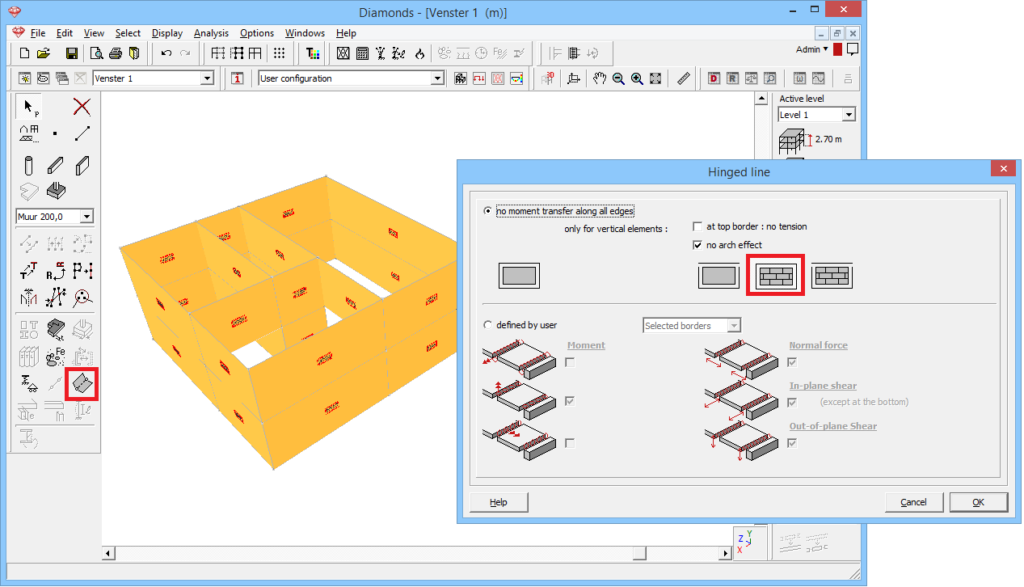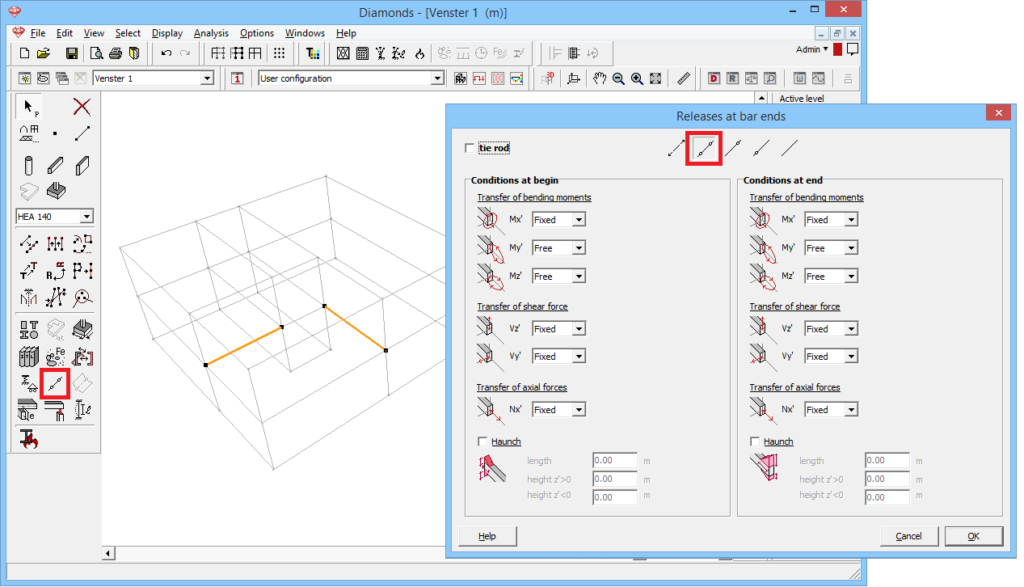Reason
Diamonds shows the real behaviour of the structure, while hand calculations/ daily reasoning make assumptions that are only valid for some cases. For example:
- The hand calculations of a plate are only valid for a plate strip in the middle of the plate, far enough from the edges.
- Préslabs is plate type which behaviour is rahter a two-way slab than a one-way slab. Yet in handcalculations, a préslab is mostly approached using one-way slab behaviour.
If the assumptions used during hand calculations are modelled in Diamonds, Diamonds will give the similar results as the hand calculations.
The question is if these hand-calculations-assumtions comply to the real behaviour of the structure? If the boundary conditions and plate-behaviour are representative for the real behavior of the structure, the Diamonds results are the most correct.
Example
Consider the example building from the image below (model attached at the end of this article). The walls have been set invisible. The loading is 12kN/m² on both the roof and the floor. Using hand calculations a bending moment of 167kNm is expected in the beam. Yet in Diamonds only a maximum bending moment of 4,0kNm is found.
![]()
![]()
| Geometry (the walls have been set invisible) | Diamonds result for My |
|---|---|
 |
 |
The following changes have been made to make the Diamonds-results correspond to hand calculations:
- Select all walls. Remove the no tension at the top of a wall-condition. ‘No tension at the top of a wall’ is something you cannot simulate in simple hand calculations.

- Define the slabs as bearing in one direction instead of préslabs. In the hand calculation, it is assumed that 50% of the loading goes to the beam. This is only true, if the slabs are bearing in one direction.

- Put hinges at the bar ends.

- Place the beams eccentric. Allow only the transfer of normal force in the rigid links.


- Define hinges on the floor edges.
- Turn off the transfer of moment, normal force and in-plane shear force for all edges.

- Additionally, turn off the transfer of out-of-plane shear for all edges parallel to the bearing direction.

- Turn off the transfer of moment, normal force and in-plane shear force for all edges.
- The Diamonds model now approximate the hand calculations well:

Reden
Diamonds toont het werkelijke gedrag van de structuur, terwijl manuele berekeningen/ dagelijkse redeneringen aannames doen die slechts voor enkele gevallen geldig zijn. Bijvoorbeeld:
- De manuele berekeningen van een plaat zijn alleen geldig voor een plaatstrook in het midden van de plaat, ver genoeg van de randen.
- Prédallen is een plaattype waarbij de lasten eerder in twee richtingen worden afgedragen i.p.v. in één richting. Toch wordt bij handberekeningen een prédal meestal benaderd met behulp van een plaat dragend in één richting.
Als de aannames die tijdens handberekeningen worden gebruikt, worden gemodelleerd in Diamonds, zal Diamonds vergelijkbare resultaten geven als de handberekeningen.
De vraag is echter of deze handberekening-aannames voldoen aan het werkelijke gedrag van de structuur? Als de randvoorwaarden en het plaatgedrag representatief zijn voor het werkelijke gedrag van de constructie, zijn de Diamonds resultaten het meest correct.
Voorbeeld
Beschouw het voorbeeldgebouw uit de onderstaande afbeelding (model bijgevoegd aan het einde van dit artikel). De muren zijn onzichtbaar gezet. De belasting is 12kN/m² op zowel het dak als de vloer. Met behulp van handberekeningen wordt een buigend moment van 167kNm in de balk verwacht. Toch wordt in Diamonds slechts een maximaal buigend moment van 4,0kNm gevonden.
![]()
![]()
| Geometrie (de wanden werden onzichtbaar gezet) | Diamonds resultaat voor My |
|---|---|
 |
 |
De volgende wijzigingen zijn aangebracht om de Diamonds-resultaten overeen te laten komen met handberekeningen:
- Selecteer alle wanden. Verwijder de randvoorwaarde ‘aan de bovenrand geen trek’. ‘Aan de bovenrand geen trek’ is iets wat je niet kan simuleren in eenvoudige handberekeningen.

- Definieer de platen als dragend in één richting in plaats van prédallen. Bij de handberekening wordt ervan uitgegaan dat 50% van de belasting naar de balk gaat. Dit is alleen waar, als de platen in één richting dragen.

- Plaats scharnieren op de uiteinden van de balken.

- Zet de balken excentrisch. Laat enkel de overdracht van normaalkracht toe in de rigid links.


- Definieer scharnierlijnen langs plaatranden.
- Schakel bovendien ook de overdracht van schuifkracht uit het vlak uit voor alle randen evenwijdig aan de draagrichting.

- Aanvullend, zet ook de overdracht van dwarskracht uit voor alle randen evenwijdig aan de draagrichting.

- Schakel bovendien ook de overdracht van schuifkracht uit het vlak uit voor alle randen evenwijdig aan de draagrichting.
- Het Diamonds model benadert nu de handberekeningen goed:

Raison
Diamonds montre le comportement réel de la structure, tandis que les calculs manuels/raisonnement quotidien font des hypothèses qui ne sont valable que pour certaines cas. Par example:
- Les calculs manuels d’une plaque ne sont valables que pour une bande au milieu de la plaque, assez loin des bords.
- Des prédalles sont un type de plaque où le comportement est une plaque bidirectionnelle plutôt qu’une plaque unidirectionnelle. Néanmoins, dans les calculs manuels, une prédalle est généralement approchée par un comportement unidirectionnel.
Si les hypothèses utilisées lors des calculs manuels sont modélisées dans Diamonds, Diamonds donnera des résultats similaires aux calculs manuels.
La question est si ces hypothèses de calcul manuel répondent au comportement réel de la structure? Si les conditions de bords et le comportement de la plaque sont représentatifs pour le comportement réel de la structure, les résultats de Diamonds sont les plus corrects.
Exemple
Considérons l’exemple ci-dessous (modèle joint à la fin de cet article). Les murs ont été rendus invisibles. La charge est 12kN/m² sur le toit et la plaque. A l’aide de calculs manuels, un moment fléchissant de 167 kNm est attendu dans la poutre. Pourtant, Diamonds donne un moment fléchissant de 4,0 kNm…
![]()
![]()
| Géométrie (les murs ont été rendus invisibles) | Résultat en Diamonds pour My |
|---|---|
 |
 |
Les modifications suivantes ont été apportées pour faire correspondre les résultats des Diamonds avec les calculs manuels:
- Sélectionnez tous les murs. Désactivez l’option «Au bord supérieur: pas de traction». «Au bord supérieur: pas de traction» est quelque chose que vous ne pouvez pas simuler dans de simples calculs manuels.

- Définissez les plaques portant en une direction au lieu des prédalles. Le calcul manuel suppose que 50% de la charge va à la poutre. Cela n’est vrai que si les plaques portent en une direction.

- Ajoutez des rotules sur les extrémités de la poutre.

- Donnez les poutres une excentricités. Autorisez uniquement le transfert de la force normale dans les liens rigides.


- Ajoutez des lignes d’articulation sur les bords des plaques.
- Désactivez le transfert du moment, de la force normale et de la force transversale dans le plan pour tous les bords.

- Désactivez aussi le transfert de la force tranchant pour tous les bords parallèles à la direction principale.

- Désactivez le transfert du moment, de la force normale et de la force transversale dans le plan pour tous les bords.
- Le modèle Diamonds aborde maintenant bien les calculs manuels:


